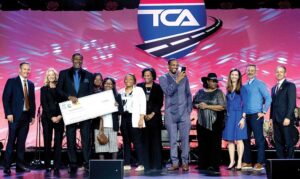WASHINGTON — The Biden-Harris administration on March 12 revealed the National Zero-Emission Freight Corridor Strategy, a plan the government says will speed the development of infrastructure to support the movement of freight by electric and hydrogen-fueled semitrucks.
The strategy, developed by the Joint office of Energy and Transportation and the U.S. Department of Energy (DOE), in collaboration with the U.S. Department of Transportation (DOT) and U.S. Environmental Protection Agency (EPA), outlines the development of charging and hydrogen fueling infrastructure for zero-emission medium- and heavy-duty trucks (ZE-MHDV) from 2024 to 2040.
A statement issued by the agencies involved described the strategy as “an all-of-government approach to aligning investments and accelerating sustainable and scalable deployment of reliable ZE-MHDV infrastructure.”
Ali Zaidi, President Biden’s national climate advisor, describes the plan as “a big move to deliver environmental justice,” stating that 75% of heavy truck traffic travels on only 4% of the nation’s roads — which he says puts the health of America’s “most vulnerable communities” at risk.
“President Biden’s historic investments in zero-emission infrastructure on those high-traffic roads and the hubs they connect will rapidly transform freight transport in the U.S. and strengthen American innovation,” he said, adding that the plan delivers “a win-win-win for frontline communities who will benefit from cleaner air, businesses that will save millions on fuel costs, and for our climate.”
U.S. Secretary of Energy Jennifer Granholm also praised the strategy, saying, “For over a century, petroleum-fueled freight has transported vital food and resources to American families but at the same time, these vehicles have also contributed to lower public health, especially in densely populated communities. The Biden-Harris administration is addressing this issue head-on with innovative strategies to transform freight so it not only supports American families and businesses, but also protects the environment for future generations.”
The U.S. National Blueprint for Transportation Decarbonization, released in January 2023, calls for 30% of all medium- and heavy-duty vehicle sales to be zero-emission by 2030, increasing to 100% by 2040.
The deployment of all these ZE-MHDVs will require convenient access to electric vehicle (EV) charging and hydrogen refueling stations along the nation’s freight corridors, as well as at intermodal freight facilities and high-usage ports.
The National Zero-Emission Freight Corridor Strategy outlines a plan to achieve this goal in four phases:
- Phase 1: Establish priority hubs based on freight volumes (2024-2027)
- Phase 2: Connect hubs along critical freight corridors (2027-2030)
- Phase 3: Expand corridor connections initiating network development (2030-2035)
- Phase 4: Achieve national network by linking regional corridors for ubiquitous access (2035-2040)
In alignment with the Joint Office’s Zero-Emission Freight Corridor Strategy and the Bipartisan Infrastructure Law (BIL), the Federal Highway Administration (FHWA) has designated National EV Freight Corridors along the National Highway Freight Network and other key roadways. These corridors will facilitate the building of a national EV charging network to serve the needs of both individual drivers and commercial transportation.
“The FHWA is pleased to announce these new freight EV corridor designations along our national highways,” said Federal Highway Administrator Shailen Bhatt. “Medium- and heavy-duty trucks in our current freight network contribute approximately 23% of greenhouse gas emissions in the U.S. transportation sector. These new designations and strategy will help to grow our national EV charging network, encourage clean commerce within the freight community, and support President Biden’s goals of achieving net-zero emissions for the nation by 2050.”
A statement from the office of U.S. Sen. Alex Padilla (D-CA) noted that he and 14 other senators, along other organizations, had previously called on the Joint Office of Energy and Transportation to prioritize the deployment of infrastructure to support medium- and heavy-duty zero-emission vehicles. Previously, the statement noted, the focus has been almost exclusively on light-duty vehicles.
“I’m grateful to the administration for advancing this whole-of-government effort and heeding my calls to launch a national strategy to accelerate the build-out of heavy-duty vehicle infrastructure,” Padilla said. “This all-hands-on-deck approach from the federal government and industry partners will enable us to realize California’s and the administration’s zero-emission goals.”
Following the announcement of the federal government’s plan to create infrastructure capable of supporting zero-emission trucks, several industry organizations weighed in on the topic.
Debbie Sparks, executive director of the National Motor Freight Traffic Association (NMFTA), said the organization has collaborated with the Joint Office and other agencies regarding the challenge of reaching zero-emission goals set for the industry.
“We appreciate that the administration recognizes the enormous task at hand to build out the needed infrastructure to electrify medium- and heavy-duty commercial vehicles,” she said. “Although the NMFTA has serious concerns related to the transition to zero-emission trucks, such as the infrastructure, the ability of all segments of the trucking industry ability to utilize battery-electric trucks and the costs of the equipment, the reduction in payload, and the possible disruption to the supply chain if the transition is required on unattainable timelines, the NMFTA looks forward to continued collaboration with the administration, agencies and Congress.”
NATSO and SIGMA, which represent truck stops, travel plazas and fuel marketers, expressed support for the plan. In a prepared statement, the groups noted that they are grateful that the Biden administration recognizes the need for infrastructure supporting zero-emission freight vehicles and that the proposed plan seeks to minimize disruptions to the industry’s operation.
“Fuel retailers are at the forefront of investments in new refueling technologies and their requisite infrastructure,” said David Fialkov, executive vice president of government affairs for NATSO and SIGMA. “We have long held that President Biden’s goal of establishing a nationwide network of electric vehicle charging stations for all vehicle classes is best achieved by harnessing the existing nationwide network of refueling locations.
“Directing states to adopt a phased approach that prioritizes investments along key freight corridors can harness the existing nationwide network of refueling locations along the interstate highway system and encourage investment in emerging refueling technology,” he continued.
In addition to the challenges of generating electricity to power EVs, he noted that fuel retailers need to see a return on their investment in the infrastructure needed to support zero-emission trucks.
“We appreciate that the Biden administration has recognized some of these concerns and appears to have developed an iterative and thoughtful approach to directing investment in a medium- and heavy-duty charging network,” he said. “We hope the administration applies the timelines permeating this strategy to other forthcoming policies that also will influence the heavy-duty refueling market’s decarbonization efforts.”
The Owner-Operators Independent Drivers Association (OOIDA) is not as enthusiastic about the plan.
“Unlike many in Washington, D.C., who develop policies affecting the trucking industry, OOIDA members have to operate in real-world conditions, taking into account practical safety, infrastructure and cost considerations,” said Todd Spencer, president of OOIDA, noting that the strategy might “sound great on paper” but that there is no guarantee that the goals can be reached in the projected timeframe, if ever.
Spencer also questioned the cost of investing in the required equipment.
“We believe that all environmental regulations must only be implemented in a reliable and affordable manner that does not price our members out of the industry. However, this has hardly been the case in recent years,” he said.
“Various emissions regulations have neglected the contributions of safe, experienced owner-operators and have not accurately estimated or properly considered the economic and operational impacts on small trucking businesses,” Spencer continued. “This has resulted in expensive breakdowns and excessive downtime for drivers, along with astronomical costs for new heavy-duty vehicles, which works against the goal of achieving cleaner air by incentivizing the prolonged use of older equipment.”
In addition, he said, the integration of zero-emission vehicles into the nation’s freight system should not be mandated by the government; instead, the timeline should be based on the technology available within the market.
“We believe adoption of these vehicles must happen in a manner dictated by the market, not Washington bureaucrats who have shown little regard for the consequences of their proposals within our industry,” he said. “When better more practical and efficient vehicles are available, mandates aren’t needed.”
To read or download the National Zero-Emission Freight Corridor Strategy, click here.
Born in Pine Bluff, Arkansas, and raised in East Texas, John Worthen returned to his home state to attend college in 1998 and decided to make his life in The Natural State. Worthen is a 20-year veteran of the journalism industry and has covered just about every topic there is. He has a passion for writing and telling stories. He has worked as a beat reporter and bureau chief for a statewide newspaper and as managing editor of a regional newspaper in Arkansas. Additionally, Worthen has been a prolific freelance journalist for two decades, and has been published in several travel magazines and on travel websites.
















another moronic idea plants need carbon dioxide to produce Oxygen this plan will never work all generating power plant use fossil fuels there’s not enough precious minerals to produce the batteries our economy and leadership is doomed China and Russia and middle east will never comply and are laughing their asses off Americans and America is broke we have a 38 trillion dollar debt more than all other nations combined thanks to stupid Government and this tyrannical administration good by to this once great nation it’s over! mark my words!